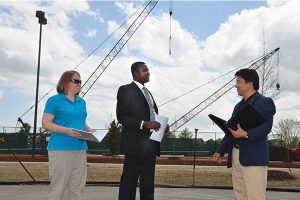Crane Safety Training for New OSHA Standards

The operation of large cranes performing heavy lifts is potentially dangerous, which is why new OSHA safety regulations are in place. The regulations are important and complex, and Lee College of Engineering Assistant Professor Chung-Suk Cho and his students are developing new training materials to help ensure crane safety is performed correctly.
The crane training project is supported by a Susan Harwood Training Grant from the Occupational Safety and Health Administration (OSHA) of the U.S. Department of Labor. The purpose of the program is to provide training and education for workers and employers on the recognition, avoidance and prevention of safety and health hazards in the workplaces.
“The motivation for the project is the 2010 OSHA regulation changes involving crane safety,” said Dr. Cho. “The Final Rule for Cranes and Derricks in Construction expands standards for crane operators, riggers and anyone involved in heavy lifts. To help them understand these standards we are developing training materials and will conduct one trial class to test the effectiveness of the materials.”
An assistant professor in Engineering Technology and Construction Management, Dr. Cho has academic and real-world large construction experience. He has an undergraduate degree in civil engineering and a Ph.D. in construction management. He worked for engineering and construction giant Fluor Corporation nearly for five years as an expert in project management and safety after completing his Ph.D.
“After my industry experience I kept an interest in safety and applied it to research,” Dr. Cho said. “I also currently teach a construction safety course that leads to authorized OSHA 10-hour training, as well as academic credit.”
Working with Dr. Cho on the crane safety project is master’s student Francis Boafo and undergraduate Amber Grimm, both construction management students.
The training is for all types of cranes and lifts, and for all of the many people involved. “It is across the board,” Dr. Cho said. “It is for anyone involved in heavy lifts including the crane operators, riggers, signalers, engineers, construction managers, contractors, inspectors and planners.
“The challenge for us is how to cover all the new OSHA details without missing sections, but also not overwhelming the trainees. They have to be able to implement this into their daily work.”
The first step in developing the training material was finding gaps between the old and new regulations. “We started with gap analysis,” Dr. Cho said. “We found that one area with a lot of change is issues related to ground conditions where cranes are set up. There are also more detailed regulations about operating around power lines. New inspection processes are also in place with much broader areas of coverage.”
With a focus on the regulation changes, Dr. Cho’s team developed its training materials. These have been submitted to industry experts for review and evaluation. Based on this feedback, final updates will be made. Dr. Cho will then conduct a pilot training session with the new safety materials for the ASCE Construction Institute Group at its national conference. The next step will be a final update based on the training session, and then submittal to OSHA.
For more information contact Dr. Cho.